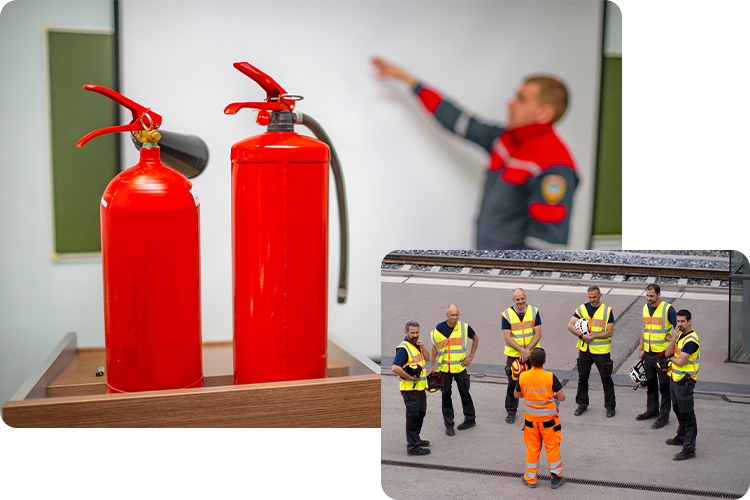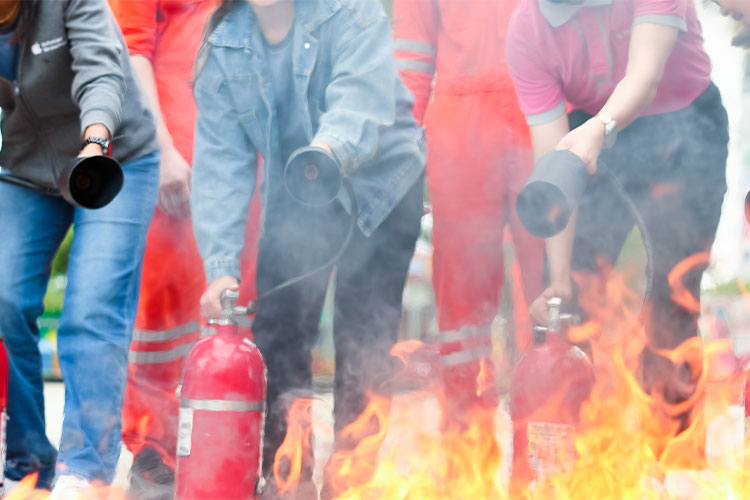
Fire Safety & Protection
Expert Training, Reliable Equipment, Highest Standards
Accreditations in FIRE safety

Fire Protection Association

Fire Industry Association

BAFE
Fire Industry Qualifications


Fire Associated Services
Veritech Systems are a manned guarding and electronic solutions company that have our own department which specialises in fire safety. Our current fire safety services include the following:
- Timber frame building protection
- Temporary alarm systems
- Analytic deep in mind CCTV systems
- Fire Wardens
- Fire safety training
- Fire extinguisher supply & servicing (serviced by BAFE qualified engineer).
We are members of the Fire Industry Association and the Fire Protection Authority. Veritech have a full-time qualified fire risk assessor, manager, fire fighter and FPA trainer, responsible for delivering the FPA Fire Warden course at out in house training facility.
FPA Trained Fire Wardens
A fire warden is a designated person within a building who supports the ongoing management of fire safety, contributing to the safety of staff and the public should a fire evacuation be required. Security Guards are often good choices for this responsibility, trained by Veritech Fire Safety for your site. We believe good fire warden training is based on the following.
- A dedicated senior manager responsible for maintaining the credibility of training courses and material
- Training courses & material only supplied by industry experts and associations (i.e. NEBOSH, IOSH & FPA)
- Classroom training and identification checks to ensure the exams are being taken by the student
- Only qualified & experienced fire safety trainers deliver our courses
- All exams are managed by a qualified examinations invigilator


Fire risk assessment and survey
A Fire Risk Assessment (FRA) and survey are essential components of fire safety management, helping to identify potential fire hazards and ensuring that appropriate measures are in place to protect people and property. Here's an overview of the key steps involved in conducting a fire risk assessment and survey:
Identify Fire Hazards - Look for heat sources such as electrical equipment, heaters, open flames, and hot surfaces. Identify materials that can burn, such as paper, fabrics, wood, chemicals, and flammable liquids. Consider ventilation systems, open windows, and other ways oxygen might feed a fire.
Identify People at Risk - Consider staff, visitors, contractors, and the public. Pay special attention to those who might need assistance in an emergency, such as elderly people, individuals with disabilities, or children.
Evaluate and Reduce the Risk - Implement measures to prevent the ignition of materials and manage sources of fuel. Check that smoke detectors, alarms, and other fire detection systems are properly installed, functioning, and adequately cover the premises. Ensure that fire extinguishers, sprinklers, fire hoses, and other firefighting tools are available, well-maintained, and accessible. Verify that emergency exits are clear, accessible, properly marked, and well-lit. Ensure there are sufficient escape routes and that everyone knows how to use them.
Review the current fire evacuation plan, ensuring that procedures for raising the alarm, calling the fire brigade, and evacuating the building are clear and known to everyone.
Record all fire hazards, people at risk, and preventive measures taken. This documentation should be comprehensive and available for review by relevant authorities or during inspections.
Ensure that all occupants, especially staff, are trained in fire safety, know the fire procedures, and can use firefighting equipment if needed.
By following these steps, you can significantly reduce the risk of fire and enhance the safety of everyone in the building.
Fire safety and evacuations
Fire safety and evacuation procedures are crucial elements of protecting lives and property in the event of a fire. These protocols are designed to prevent fires from occurring and ensure that everyone in a building can evacuate safely and efficiently if a fire does break out. Here’s a look at fire safety and evacuation procedures:
Fire Safety: Prevention and Preparedness
Fire safety is about creating a safe environment by minimising the risk of fire and ensuring there are protective measures in place to control and extinguish fires if they occur.
- Fire Prevention Measures
- Limit Fuel Sources
- Good Housekeeping
- Electrical Safety
- Fireproofing and Safety Systems
Fire Detection Systems
Smoke Detectors and Fire Alarm and Automatic Sprinkler Systems
Firefighting Equipment
Fire Extinguishers: Provide appropriately rated fire extinguishers (for example, water, foam, CO2, or dry powder) in accessible locations. Train staff on how to use them.
Fire Blankets: Useful in smothering small fires, especially those related to cooking or electrical fires.
Emergency Lighting and Signage: Ensure that emergency exits are clearly marked with illuminated signs, and that emergency lighting is installed to guide occupants to safety during power outages.
Evacuation Procedures: Ensuring a Safe Exit
A key component of fire safety is ensuring that all building occupants can evacuate quickly and safely during a fire. Effective evacuation procedures are essential to minimise confusion and ensure everyone knows how to leave the building safely.
Creating an Evacuation Plan with: Escape Routes, Multiple Exits, Assembly Points and Evacuation Maps
Fire Drills
Conduct regular fire drills to ensure that all employees and occupants are familiar with the evacuation procedures. These drills should simulate a real fire event to test the response time, identify any bottlenecks in the process, and improve coordination.
After each drill, review the outcomes and make necessary adjustments to the evacuation plan.
Legal Compliance
Many regions have fire safety regulations that require buildings to have proper fire safety measures and evacuation plans in place. Comply with local laws and ensure regular inspections and audits of fire safety systems.
Fire safety and evacuation procedures are critical for minimising the risks associated with fires. By implementing proper fire prevention measures, maintaining fire detection and suppression systems, and preparing effective evacuation plans, you can ensure the safety of everyone in a building. Regular training and drills help reinforce these procedures, making sure that in the event of a fire, all occupants know exactly what to do to protect themselves and others.


Fire Systems & Equipment
Wireless Fire Alarm Systems
Flexible, Dependable Fire Safety
Wireless fire alarm systems are a quick and efficient way to bring your site up to legal and insurance requirements. Being wireless, they aren't dependent on hazardous mains power and can be easily moved to support the growth of your site without incurring any delays.
We work with a number of 3rd party providers, combining our excellent security and 24/7 operation with their highly tested, accredited and proven products.
Our wireless Alarm systems send alerts straight to our 24/7 Monitoring Centre.
Following the highest Fire Safety Standards
- All fire wardens have mobile phones and 4G PPT radios. This provides them with a single button connection to our control room to trigger an emergency event and the ability to communicate with the emergency services at the same time.
- Fire wardens have tracking system software, to adhere to our high standards of lone worker protection and to prove to clients that patrols are being completed. In the event of an emergency event, our control room can view live tracking data on the dedicated event screen.
- All fire extinguishers supplied to a project will be commissioned and serviced by one of our BAFE qualified servicing engineers.
- Prior to the commencement of a fire warden contract, a survey of the site would be conducted by one of our fire risk assessors and a detailed report produced to identify issues that need
How Can We Help Manage Your Premises Security?
Get in touch with us today and have one of our specialised team guide you through the process. We take time to understand you and your requirements, we don't believe in a one size fits all solution.
How Our Security Services Have Helped Others
Security Services Backed By Industry Leading Technology


































